It looks like you're using an Ad Blocker.
Please white-list or disable AboveTopSecret.com in your ad-blocking tool.
Thank you.
Some features of ATS will be disabled while you continue to use an ad-blocker.
share:
a reply to: DAZ21
Damn I wrote a long reply and then lost it by going to the upload page.
Yes a caldera (dome) collapse would likely have a M6 or M7 to go with it.
The earthquakes are the only indication we have of the direction of the lava flow.
I believe "dyke/dike" is the wrong term, dykes hold things back.
This is more a "fracture" or "fissure" that is being created by the earthquakes, or really by the pressure of the lava.
The magna chamber appears to be emptying, and as it does the inside walls collapse, causing the larger earthquakes 4.7+.
thats the short theory anyway.
I've been making an animated GIF of the earthquakes on an hourly basis, but I started pretty late and its no use for seeing whats happening right now.
here are a few screenshots from it.
Red crosses are the last hours events, the grey crosses are the ghosts of previous quakes.
right click, "view image" to see full size, then click "back" to come back here
this one is at 16/08/2014 21:00 - 22:00 as the earthquake start to take a turn to the NE
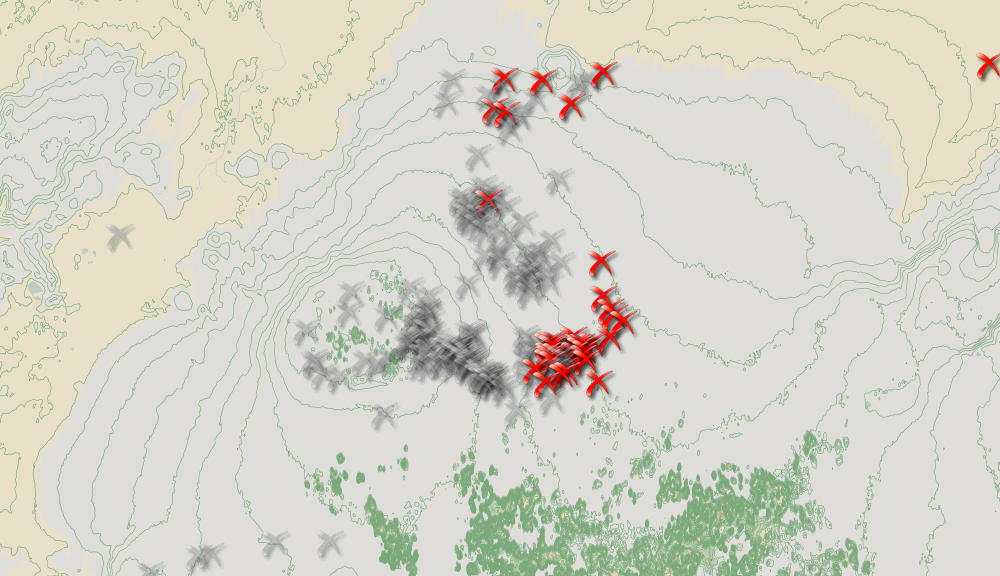
this one is at 17/08/2014 16:00-17:00 as the quakes progress along the fracture
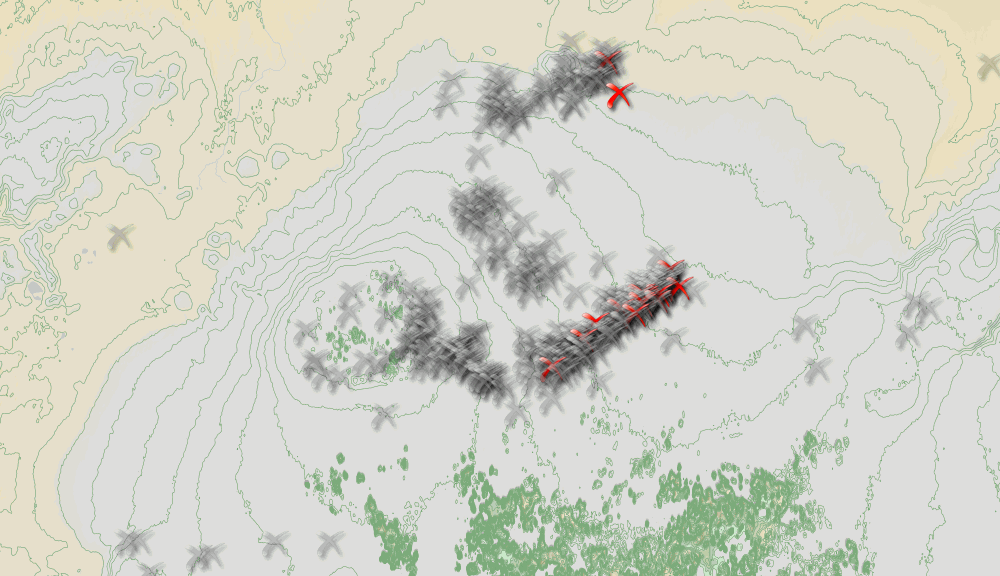
this one is at 22/08/2014 3:00-4:00
shows the first 4.7 which was 4 hrs prior

So there are two things going on here, chamber collapse and fracturing along the fissure to the NE
data recently shows the fissure has progressed in the last 12 hours a lot further NE than these early images show.
Damn I wrote a long reply and then lost it by going to the upload page.
Yes a caldera (dome) collapse would likely have a M6 or M7 to go with it.
The earthquakes are the only indication we have of the direction of the lava flow.
I believe "dyke/dike" is the wrong term, dykes hold things back.
This is more a "fracture" or "fissure" that is being created by the earthquakes, or really by the pressure of the lava.
The magna chamber appears to be emptying, and as it does the inside walls collapse, causing the larger earthquakes 4.7+.
thats the short theory anyway.
I've been making an animated GIF of the earthquakes on an hourly basis, but I started pretty late and its no use for seeing whats happening right now.
here are a few screenshots from it.
Red crosses are the last hours events, the grey crosses are the ghosts of previous quakes.
right click, "view image" to see full size, then click "back" to come back here
this one is at 16/08/2014 21:00 - 22:00 as the earthquake start to take a turn to the NE

this one is at 17/08/2014 16:00-17:00 as the quakes progress along the fracture

this one is at 22/08/2014 3:00-4:00
shows the first 4.7 which was 4 hrs prior

So there are two things going on here, chamber collapse and fracturing along the fissure to the NE
data recently shows the fissure has progressed in the last 12 hours a lot further NE than these early images show.
edit on 0800000023523514 by muzzy because: * note to self, write replies in Notepad, not the reply box.
Dike (geology) is the correct term, but as you suggest, an nearly opposite meaning to
"dike/dyke" the structure.
Cool images, Muzzy.
Cool images, Muzzy.
Has anyone else caught the buzz that this thing may be/may have found an old fissure from Askja volcano/caldera? The general trend of movement seems
to be very quick and in that direction.
a reply to: muzzy
Thanks for shedding some light on this. I always look for your post about what is going on and this makes sense as you explain it.
Still scratch my head a bit about the happenings going on under that volcano. This still may not be a good thing with the pressure release in the caldera. If enough pressure is release (like by a release at the fissure) could we also see a collapse of the dome and therefore another path of lower pressure for the magma. Kinda like a one two punch or is my imagination in overdrive. I'm new to this and really started watching because of Yellow stone but find this fascinating.
Thanks for shedding some light on this. I always look for your post about what is going on and this makes sense as you explain it.
Still scratch my head a bit about the happenings going on under that volcano. This still may not be a good thing with the pressure release in the caldera. If enough pressure is release (like by a release at the fissure) could we also see a collapse of the dome and therefore another path of lower pressure for the magma. Kinda like a one two punch or is my imagination in overdrive. I'm new to this and really started watching because of Yellow stone but find this fascinating.
a reply to: muzzy
just posted
Until 19:00 today, 24. August, around 1.300 earthquakes have been automatically detected under northwestern Vatnajökull. The vast majority is around the northernmost tip of the dike intrusion at Dyngjujökull.
The tip of the earthquake cluster has migrated throughout the night and today to 4 km north of Dyngjujökull. The propagation of the intrusion was slower than yesterday.
More than 20 events at the tip of the intrusion were stronger than M3, four of them M4-M4.3. Event depths are still around 5-12 km, no sign of upwards migration or low frequent tremor.Following the M5.3 and M5.1 earthquakes in the caldera of Bárðarbunga, one M4.8 (15:00) and several smaller events occurred in the caldera.
Focal mechanisms of the strongest events indicate subsidence of the volcano due to volume decrease underneath, similar to past days.
just posted
Until 19:00 today, 24. August, around 1.300 earthquakes have been automatically detected under northwestern Vatnajökull. The vast majority is around the northernmost tip of the dike intrusion at Dyngjujökull.
The tip of the earthquake cluster has migrated throughout the night and today to 4 km north of Dyngjujökull. The propagation of the intrusion was slower than yesterday.
More than 20 events at the tip of the intrusion were stronger than M3, four of them M4-M4.3. Event depths are still around 5-12 km, no sign of upwards migration or low frequent tremor.Following the M5.3 and M5.1 earthquakes in the caldera of Bárðarbunga, one M4.8 (15:00) and several smaller events occurred in the caldera.
Focal mechanisms of the strongest events indicate subsidence of the volcano due to volume decrease underneath, similar to past days.
Dike intrusion now north of Dyngjujokull
From the article:
@batcrapcrazy
That would really suck, but it does seem possible...unless the main magma chamber under Bardarbunga is being constantly refilled by magma from much deeper in the mantle.
ETA: There is another mag 5+ hitting the Iceland seismos right now.
You can see the P-wave just registering on the last line of this image:
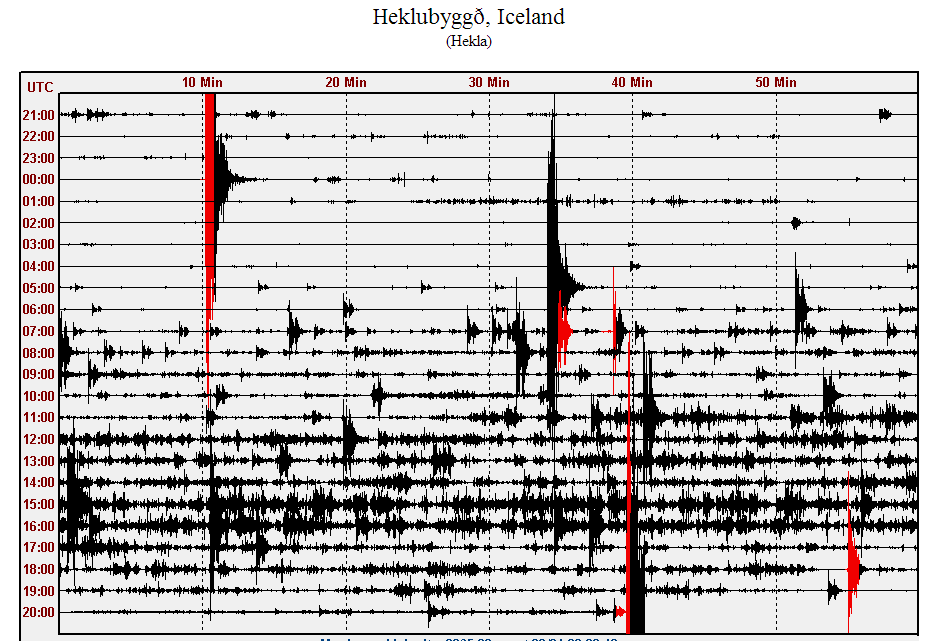 (click image for full size)
(click image for full size)
source
From the article:
Seismic activity has now been detected about 4 km outside the glacier. 270 million m³ of magma are thought to have flowed.
The propagation seems to have slowed, but is still continuing. Several strong earthquakes larger than magnitude 3 have occurred at the tip of the intrusion today. One interpretation could be that the magma is hitting colder and more resistive rock as it migrates further away from the volcano, but this is only an idea so far.“
@batcrapcrazy
If enough pressure is release (like by a release at the fissure) could we also see a collapse of the dome and therefore another path of lower pressure for the magma.
That would really suck, but it does seem possible...unless the main magma chamber under Bardarbunga is being constantly refilled by magma from much deeper in the mantle.
edit on 8/24/2014 by Olivine because: formatting
ETA: There is another mag 5+ hitting the Iceland seismos right now.
edit on 8/24/2014 by Olivine because: (no reason given)
You can see the P-wave just registering on the last line of this image:

source
edit on 8/24/2014 by Olivine because: add image
Well, that one is doing some rock breaking near the northern terminus of the dike intrusion.
Mag 5.3 Mag 4.9 from EMSC. (revised lower)
From USGS (always late to the party) Mag 5.3
Here is what it looked like in the GEE:

Doesn't seem to be wanting to slow down just yet...
From USGS (always late to the party) Mag 5.3
Here is what it looked like in the GEE:

Doesn't seem to be wanting to slow down just yet...
edit on 8/24/2014 by Olivine because: add image
edit on 8/24/2014 by
Olivine because: mohr data
a reply to: egoli
Wow, what a terrific article. Thanks for posting it.
This part makes me think we could be in for one heck of an eruption--one that lasts weeks, months, maybe even longer.
Wow, what a terrific article. Thanks for posting it.
This part makes me think we could be in for one heck of an eruption--one that lasts weeks, months, maybe even longer.
Back in 2010 Icelandic Met Office issued a statement that a phase of increased volcanic unrest was to be expected. These phases are due to Icelandic volcanism being cyclical, and there are two cycles. One is the Icelandic Mantleplume activity cycle; the other is the Icelandic MAR rift cycle. This time around both cycles would coincide.
More from the link provided by egoli
Good must read linky
And most importantly
P
Good must read linky
But let me start with why I think this is an option. Foremost the length of the fissure, at 40km it is definitely long enough to be able to sustain a large eruption. The fissure is also showing signs of having opened up down to the mantle at places, and that would mean that it is possible for rapid decompression melt to occur, and that is a necessity for a large rifting fissure eruption to access large enough quantities of magma.
The most surprising sign though is that this rifting fissure is not following a single fissure swarm. This is totally unsuspected behavior that nobody has even guessed at in their most feverish fantasies. The initial intrusion charged straight out of the Bárðarbunga fissure swam, passed barren land in between fissure swarms and connected with the Grimsvötn northern fissure swarm, followed that downstream and then once again changed trajectory and entered the fissure swarm of Askja.
This means that potentially the intrusion might be feeding on the 3 largest Icelandic volcanoes if the fissure evolves a bit more. If this actually happens all bets are off and we would be most likely talking about a rifting fissure eruption with explosive components. If the intrusion continues to move forward in this direction it will enter the caldera of Askja in 4 days. Problem here is that Askja is known to have pockets of rhyolitic explosive magma, and if those pockets suddenly reheat from the new hot magma things could get interesting fast.
And most importantly
But one thing is certain, it would not in any way threaten life on earth, it would not even put a big hindrance on your daily life. Get real, the world will not end like this. But, expect a bit of nuisance.
P
Damnit! the lava has outsmarted me!
I've done 62 hours worth of images to build an animated GIF using a standard screen capture setting,
but I just been reading how there were 1200+ events overnight and the "dike" has extended further NE
the new extent of the swarm is outside the old screen capture parameters
back to the drawing board

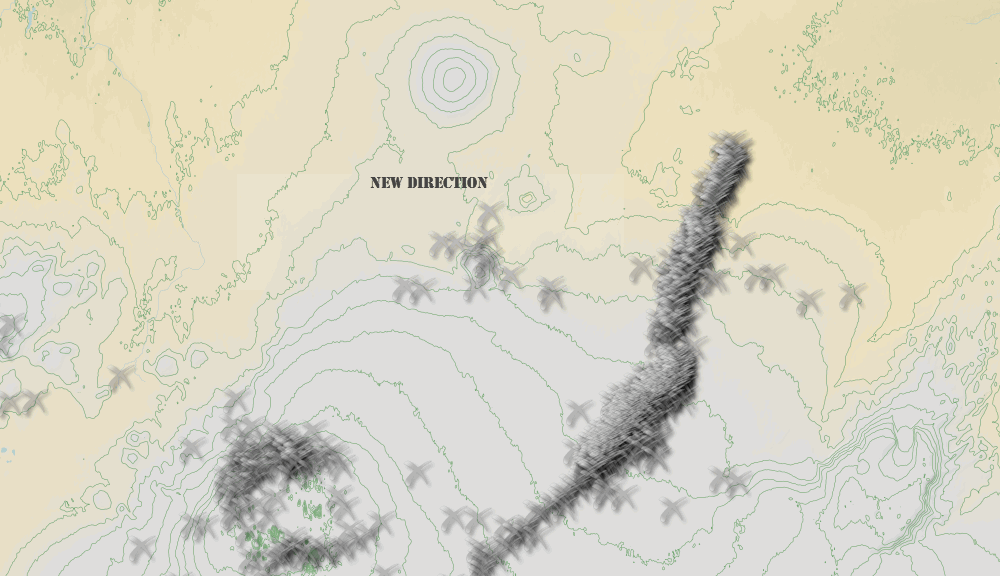
right click and "view image" for larger version
OK I have reset the center, shifted my W8 menu to the side instead of the bottom just so I can get all the events in the image,
now to start again.
If it keeps moving towards Askja then the project is screwed
new parameters
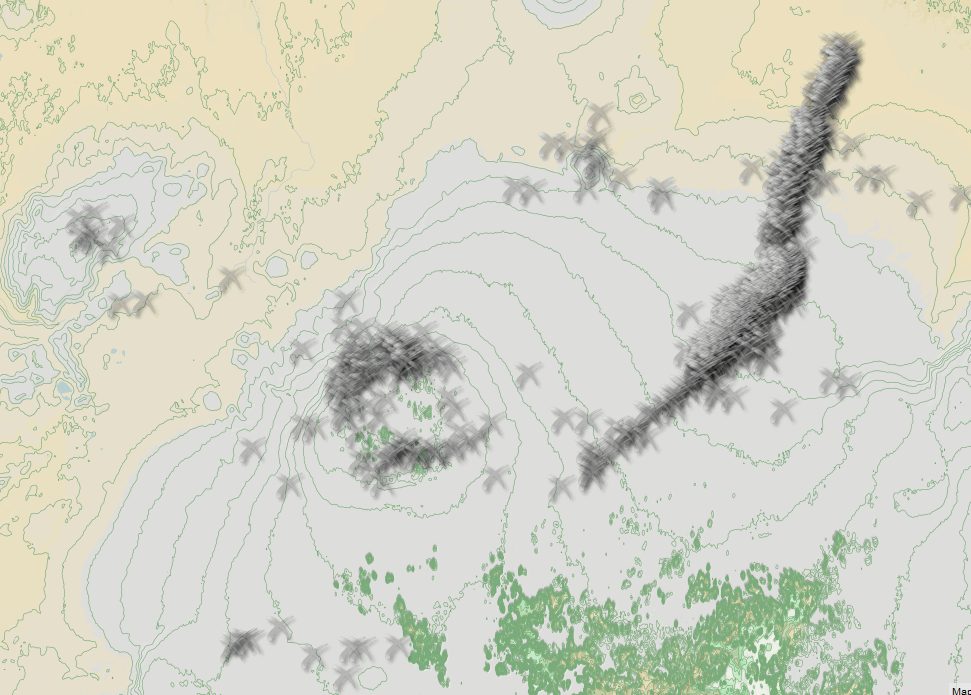
unfortunately I can't zoom out to catch Askja, as the contour (topo) map reverts to .............. glacier
I've done 62 hours worth of images to build an animated GIF using a standard screen capture setting,
but I just been reading how there were 1200+ events overnight and the "dike" has extended further NE
the new extent of the swarm is outside the old screen capture parameters
back to the drawing board


right click and "view image" for larger version
edit on 08u23523514 by muzzy because: (no reason given)
OK I have reset the center, shifted my W8 menu to the side instead of the bottom just so I can get all the events in the image,
now to start again.
If it keeps moving towards Askja then the project is screwed
new parameters

unfortunately I can't zoom out to catch Askja, as the contour (topo) map reverts to .............. glacier
edit on 0800000023523514 by muzzy
because: (no reason given)
im not sure if this has been posted yet or not, as to the current aviation status of all of icelands volcanoes ...
en.vedur.is...
all but one are green ... cheers to all of you who are keeping this thread alive despite it being a quiet year so far as i can see.unless im a idiot ...
en.vedur.is...
all but one are green ... cheers to all of you who are keeping this thread alive despite it being a quiet year so far as i can see.unless im a idiot ...
edit on 24/8/14 by alysha.angel because: (no reason given)
There is some interesting activity in (maybe) dormant volcano Tungnafellsjökull. There was 3.0 magnitude quake, and it was quite shallow, only 1,9km
deep. That volcano has not erupted at least for 10 000 years, and there is no records of its previous eruptions either. Its quite small, and it has
had some quake swarms during recent years, but they have been very minor with just few quakes.
Tungnafellsjökull is one with green star. Its stratovolcano with caldera and vents, covered in ice.

Tungnafellsjökull is one with green star. Its stratovolcano with caldera and vents, covered in ice.

Update 8/25/2014 from Volcano Discovery:
“The seismic crisis in Bárðarbunga and Dyngjujökull continues strongly. Today alone, more than 400 quakes of magnitudes up to 4 were detected, mostly at the N end of the active intrusion that has been going on. The location of the quakes indicating the front of the magma intrusion (dyke) continues to advance northwards. Its tip is now outside the glacier and approaching the Askja caldera. In case of an eruption, it is now more likely that at least some of it occurs on land (and not under the glacier).
In total, the intrusion has a length of approx. 40 km. Horizontal displacement in the crust, based on GPS data, approaches 1 meter above the dyke. A rough estimation of the volume of intruded magma is about 1 cubic kilometers.
The likelihood of a large (or even very large) rifting fissure eruption is becoming greater each day. This would occur as soon as the underground intrusions "open the lip" of the fissures on the ground and let magma to rise and decompress, producing violent lava fountaining eruptions.”
www.volcanodiscovery.com...
“The seismic crisis in Bárðarbunga and Dyngjujökull continues strongly. Today alone, more than 400 quakes of magnitudes up to 4 were detected, mostly at the N end of the active intrusion that has been going on. The location of the quakes indicating the front of the magma intrusion (dyke) continues to advance northwards. Its tip is now outside the glacier and approaching the Askja caldera. In case of an eruption, it is now more likely that at least some of it occurs on land (and not under the glacier).
In total, the intrusion has a length of approx. 40 km. Horizontal displacement in the crust, based on GPS data, approaches 1 meter above the dyke. A rough estimation of the volume of intruded magma is about 1 cubic kilometers.
The likelihood of a large (or even very large) rifting fissure eruption is becoming greater each day. This would occur as soon as the underground intrusions "open the lip" of the fissures on the ground and let magma to rise and decompress, producing violent lava fountaining eruptions.”
www.volcanodiscovery.com...
Seems like quakes have stopped under the Bárðarbunga caldera. Last quake inside the caldera was 4 hours ago. That is extremely weird if you look
yesterday's activity within the caldera, when all the strong ones struck there. I wonder what has happened there. I could make bet that there will be
5.5+ magnitude earthquake within 24 hours inside the caldera, as the magma keeps escaping under it. Or there is constant source of magma under the new
dike, as that magma should come from somewhere. Maybe Bárðarbunga is empty of magma now, or ice solidified it. Some people say that the magma from
Bárðarbunga has already reached Askja, and Askja could erupt soon. Anyhow, the new dike has reached ice-free land and is no longer under the
glacier. There is around 300 million cubic meters of magma inside the intrusion.
en.vedur.is...
en.vedur.is...
new topics
-
MULTIPLE SKYMASTER MESSAGES GOING OUT
World War Three: 18 minutes ago -
Two Serious Crimes Committed by President JOE BIDEN that are Easy to Impeach Him For.
US Political Madness: 1 hours ago -
911 emergency lines are DOWN across multiple states
Breaking Alternative News: 1 hours ago -
Former NYT Reporter Attacks Scientists For Misleading Him Over COVID Lab-Leak Theory
Education and Media: 3 hours ago -
Why did Phizer team with nanobot maker
Medical Issues & Conspiracies: 3 hours ago -
Pro Hamas protesters at Columbia claim hit with chemical spray
World War Three: 3 hours ago -
Elites disapearing
Political Conspiracies: 6 hours ago -
A Personal Cigar UFO/UAP Video footage I have held onto and will release it here and now.
Aliens and UFOs: 6 hours ago -
Go Woke, Go Broke--Forbes Confirms Disney Has Lost Money On Star Wars
Movies: 8 hours ago -
Freddie Mercury
Paranormal Studies: 8 hours ago
top topics
-
British TV Presenter Refuses To Use Guest's Preferred Pronouns
Education and Media: 13 hours ago, 17 flags -
Go Woke, Go Broke--Forbes Confirms Disney Has Lost Money On Star Wars
Movies: 8 hours ago, 12 flags -
Pro Hamas protesters at Columbia claim hit with chemical spray
World War Three: 3 hours ago, 10 flags -
Trump To Hold Dinner with President of Poland At Trump Tower Tonight
2024 Elections: 16 hours ago, 8 flags -
Elites disapearing
Political Conspiracies: 6 hours ago, 7 flags -
Freddie Mercury
Paranormal Studies: 8 hours ago, 7 flags -
Tucker Carlson interviews Christian pastor from Bethlehem.
Middle East Issues: 15 hours ago, 7 flags -
A Personal Cigar UFO/UAP Video footage I have held onto and will release it here and now.
Aliens and UFOs: 6 hours ago, 5 flags -
Nirvana - Immigrant Song
Music: 12 hours ago, 4 flags -
Why did Phizer team with nanobot maker
Medical Issues & Conspiracies: 3 hours ago, 3 flags
active topics
-
-@TH3WH17ERABB17- -Q- ---TIME TO SHOW THE WORLD--- -Part- --44--
Dissecting Disinformation • 516 • : cherokeetroy -
MULTIPLE SKYMASTER MESSAGES GOING OUT
World War Three • 1 • : annonentity -
Two Serious Crimes Committed by President JOE BIDEN that are Easy to Impeach Him For.
US Political Madness • 3 • : ElitePlebeian2 -
AARO/Dr Kirkpatrick-Caught Lying in UAP report.
Aliens and UFOs • 24 • : Ophiuchus1 -
Go Woke, Go Broke--Forbes Confirms Disney Has Lost Money On Star Wars
Movies • 15 • : 5thHead -
911 emergency lines are DOWN across multiple states
Breaking Alternative News • 0 • : TheGoondockSaint -
Pro Hamas protesters at Columbia claim hit with chemical spray
World War Three • 10 • : KrustyKrab -
Elites disapearing
Political Conspiracies • 16 • : annonentity -
Israel ufo shoot down drones?
Aliens and UFOs • 25 • : introufo2 -
Why did Phizer team with nanobot maker
Medical Issues & Conspiracies • 3 • : Unknownparadox
